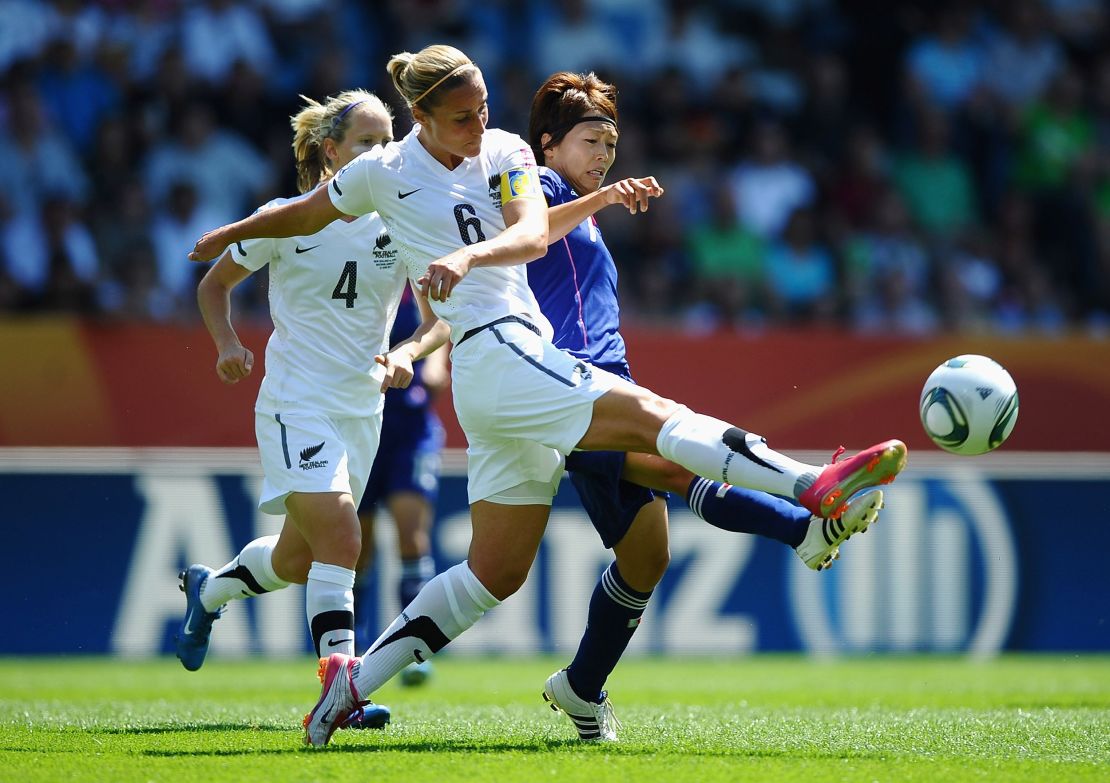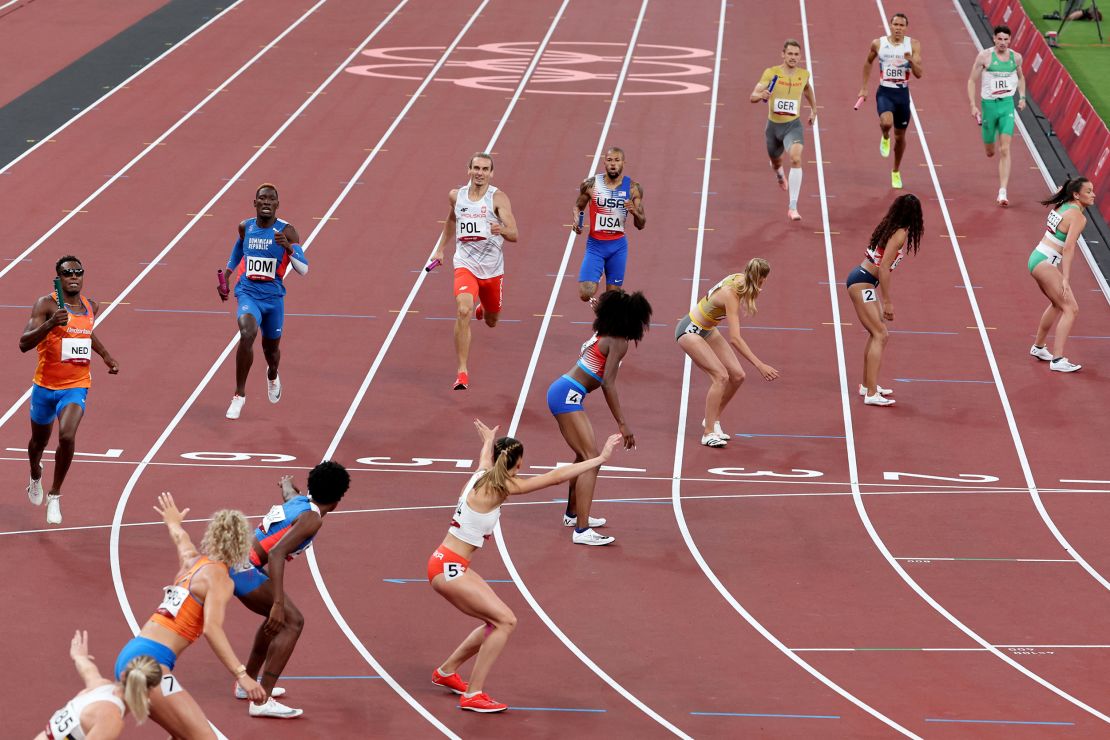When Rebecca Smith sat down to watch New Zealand play the United States Women’s National Team in a Tokyo 2020 football match last week, she was floored – and not just because of the athletes’ incredible prowess.
Watching the game from London, a British commentator kept calling an American forward by the wrong name. The commentary of Great Britain’s game against the Netherlands has also provoked dismay after the a commentator got two players’ names wrong and seemed to be under the mistaken assumption that Phil Neville is still the GB coach – he left in January.
For Smith – a two-time Olympian footballer who also captained the New Zealand team – listening to the commentary of the Football Ferns playing the USWNT was like entering a time warp: It had happened to her and her teammates throughout her whole career.
“There wasn’t really any time where I really felt like this full panel of media is really interested in the game, follows the game (or) knows really in-depth about the game,” Smith told CNN Sport.
To see that some commentators still hadn’t done the “absolute minimum” of learning an Olympic athlete’s name “basically reinforces that stereotype that no one is watching, (that) no one cares about women’s football, or female athletes,” Smith said.
Roll their eyes
Academics studying the intersection of gender and sport highlight the fact that commentators continue to use the word “girls” to describe elite female athletes, regardless of their age, while they would rarely refer to male athletes as “boys.”
Janet Fink, an expert in the marketing of female athletes and women’s sport and the Associate Dean of University of Massachusetts Amherst told CNN that it was hard to understand how in 2021 “you could call someone who’s a world-renowned athlete a girl.”
“I mean, if you just flipped it, and you thought about a commentator talking about (a male athlete as a) boy…it’s comical.”
Fink added that she believes that sort of language has an impact on how people perceive female athletes, but that it is unclear how that language impacts how female athletes view themselves.
She said: “I think they probably roll their eyes a lot of times at some of those commentators.”
Still, visibility and interest for women’s sport continues to grow, with former and current athletes often playing a significant role lifting those profiles, according to Smith.
A 2018 Nielsen Sports study found that the volume of media coverage of women’s sports across Europe ranged from as low as 2% to just 12% at peak times, whereas the Olympics represent a more balanced playing field in terms of competition. Plus, the Olympics tends to fare better in terms of balanced coverage for women’s sport than in the normal sports landscape.
A record number of female athletes participating in the Tokyo 2020 Olympics might signal yet another indicator of a that progression. But gender inequality still very much exists at the Games, with the infantilization and sexualization of female athletes a pervasive force.
Smith points to another Olympic football match last week, where a Team GB athlete’s “swishing blonde” ponytail was the subject of commentary, or how one male commentator pontificated about the “beautiful” smile of a a rugby sevens player.
Ahead of 2020 Games, the International Olympic Committee (IOC) released new guidelines for the media to counter such coverage, encouraging broadcasters to put gender equality at the forefront of coverage, to avoid sexualizing women and to treat all athletes with integrity, instead of focusing “unnecessarily on looks, clothing or intimate body parts.”
But even the IOC’s new gender equality advisor, the former Olympic swimmer Naoko Imoto, has said host country Japan was failing in that regard.
Last week she blasted her home country’s coverage, saying that Japanese broadcasters continue to use the word “girls,” “wives” or “mothers” when describing the athletes, instead of focusing on them as “pure athletes.”
‘Fastest vs. pregnant’
It is language that researchers at Cambridge University have identified as consistent with general sports reporting.
In a 2016 study, researchers found that men are mentioned almost three times more often than women in general sport reporting, with language around female athletes focusing disproportionately on aesthetics and personal lives.
The study – which drew from a multi-billion word database of written and spoken English from a wide range of media sources – found that men are seen to have a competitive edge in sport, with male athletes associated with the words “fastest,” “strong,” “beat,” “win,” and “dominate.”
Meanwhile, female athletes were associated with the words “aged,” “pregnant,” “married,” “compete,” “participate” and “strive.”
The researchers drew from the same data to analyze how those word associations would play out at the Rio 2016 Olympics.
While they found that some language had improved, with the use of the gender-neutral term “sportsperson” used with higher frequency in comparison to the language of sports in general, men’s sports still received 20% more airtime at the Olympics.
Culture plays a part.
Professor Toni Bruce, an expert in the sociology of sport at the University of Auckland told CNN: “I think sports media reflects society. So as society changes, then sports media changes, but it’s often running behind the change – not necessarily leading it.”
New Zealand is a good example of societal change leading the way for sport coverage, she explained, noting that in the 12 channels broadcasting Olympic coverage this week to be generally good with gender-neutral terminology – with commentators using words such as “strength” and “ability” when speaking about women.
Underpinning that language is New Zealand’s structural commitment to gender parity: The country sits in fourth place for gender equality, according to the 2021 World Economic Forum Index.
“There is sort of a kind of energy in New Zealand at the moment around gender equality and making sure that we do the best job and don’t fall into these old tropes in terms of how you talk about female athletes,” Bruce said.
When there is a real commitment towards gender equality and growing women’s sport, coupled with growing the diversity of people who are commenting, writing or in charge of news coverage, significant progress can be made, Bruce said.
Still, she acknowledged that New Zealand is likely to be in a “different place as a nation compared to some of the other countries.”
This rings true for Smith, who played 74 times for New Zealand and whose 10-year international football career brought her to clubs in the US, Germany, Sweden and Switzerland.

In Germany, the media continued to perpetuate narrow and damaging stereotypes of female footballers, she said, even when their team thrice held the title of European champions.
But in places like the US (where Title IX, the landmark gender equity law passed as part of the Education Amendments of 1972 banned sex discrimination in federally funded education programs), or in Sweden (where gender equality across socio-political and economic landscapes is robust), language around women in sport appeared to be much more concentrated on terms like “athleticism” and “strength,” she said.
Smith then looks to England’s difficult history with women’s football, explaining that although it claims to be the home of the sport, women were essentially banned in 1921 from playing it – a measure that lasted for 50 years.
“I think that really set them behind both in like the performance and the athletes,” Smith said, “but also in commentary and how they look at athletes and how they look at women.”
She added that those practices still prevail, pointing to the fact that schoolgirls are still unable to play or access the same opportunities to play football as boys, with many encouraged to take up netball instead.
This segregated nature of sport was noted in the 2016 Cambridge study, which found that the only context where women are mentioned more in reporting is to delineate their sports as “other” – meaning that men’s sport is often considered the norm.
Basketball, golf, football and cycling is often just called by their names, while female teams will be marked as “women’s basketball, women’s golf, women’s football.”
Kyoung-yim Kim, Assistant Professor of the Practice of Social Science at Boston College, explains that ultimately these problems stem from a “sex-segregated structure” that is “based on the sexist understanding of gender differences.”
“It is this understanding of gender that causes this problematic media coverage of girls of women,” Kim said, adding that the infantilizing and “ambivalent framing of women’s accomplishment” in sport stems from our social understanding of gender.
In order to change this language, that entire system has to be challenged, she said.
This year, Tokyo 2020 is hosting 18 mixed-gender events.

But Kim suggests the IOC has more work to do, pointing to the fact there is no third gender or intersex delegation as well as the continued regulation of women’s participation in sport through “sex testing” – practices that human rights advocates including Human Rights Watch say violate fundamental rights to privacy and dignity.
“The IOC and their entire structure of sport basically reproduces and embodies the binarized and hierarchical forms of gender,” said KIm.
“If they want to challenge this sexist language and hierarchical language then there should be discussions, at least, to talk about how the IOC can be a frontline institution thinking critically about this binary notion about sport structure as a whole.”
The IOC told CNN Sport that it is “committed to inclusion across the Olympic Movement and recognizes that all athletes, regardless of their gender identity or sex characteristics should engage in safe and fair competition,” and that the current guidance on eligibility to complete in male and female competition – issued in 2015 – is currently under review.
“Recognizing that there is a perceived tension between fairness/safety and inclusion/non-discrimination, and in consideration of the latest developments on many fronts, the IOC has decided in October 2019 to work on a new comprehensive and rights-respecting approach to address the complexity of this issue.
Currently, the IOC is developing new guidance to help ensure that athletes – regardless of their gender identity and/or sex characteristics – can engage in safe and fair competition,” the organization said.
There has been much debate about the inclusion of transgender athletes in the Games, with the IOC saying that they will review guidelines for trans athletes after Tokyo 2020.
“I am not entirely unaware of the controversy which surrounds my participation at these Games,” said New Zealand weightlifter Laurel Hubbard, who became the first out transgender woman to compete in the 125-year history of the Olympics on Monday.
“And as such, I would particularly like to thank the IOC for, I think, really affirming its commitment to the principles of Olympism and establishing that sport is something for all people. It is inclusive, accessible.”
For Smith, who now works as a consultant, there are clear steps that we can take to drive this change, including elevating former athletes who can speak from a position of experience and authority to commentator roles, as well as investing in more women (and diversifying talent) at the executive level.
Without that commitment, the cycle will continue, with the next generation not living up to their full potential, she said.
“If we’re constantly feeding them messages that are not gender equal, that are racist or homophobic or not inclusive, then I think that we’re bringing up a generation that’s going to be ignorant and not inclusive – and we’re not going to be the best form of the human race that we can be,” Smith said.
Illustration by CNN’s Woojin Lee









